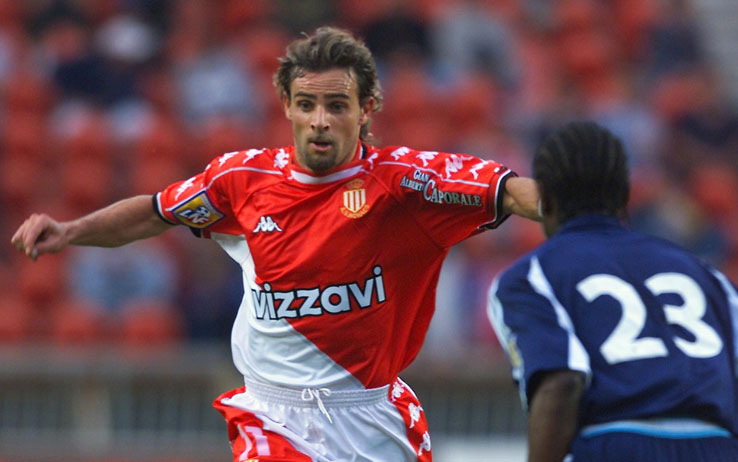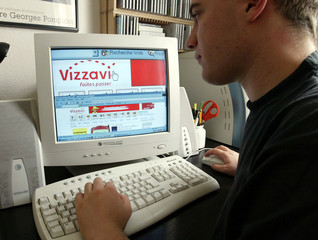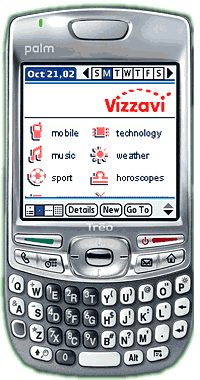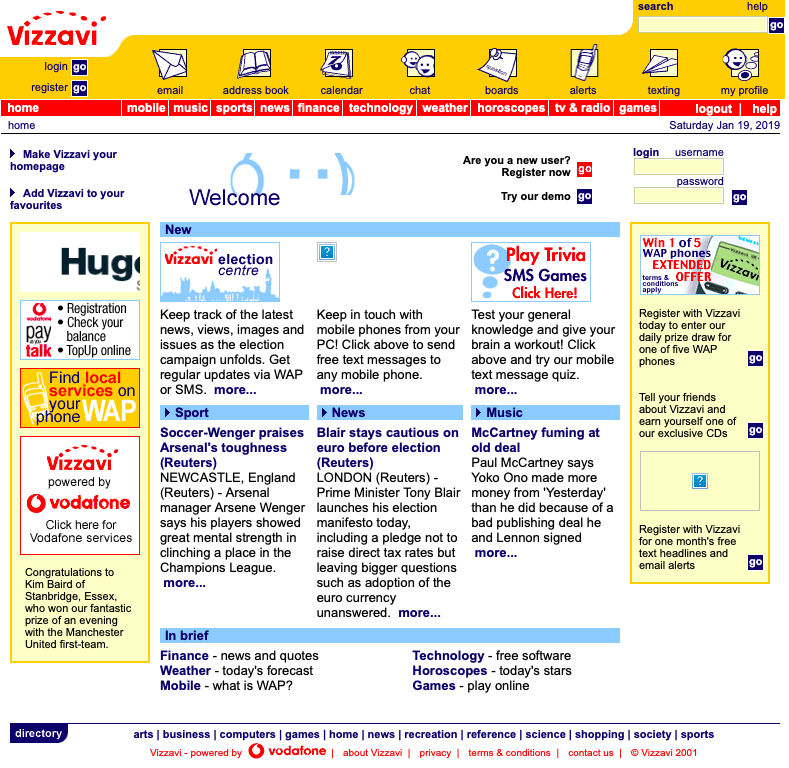
Vizzavi was co-founded in early 2000 by Vodafone and Vivendi Universal with a €1.6 billion investment plan that made it one of the most expensive start-ups in Internet history. This is a small part of the Vizzavi story, the dot com boom and bust in Europe, the start of the mobile Internet, and my small part in all of it.

In mid 2000, I left one of Perth’s pioneering web development agencies Pretzel Logic, and followed a well worn trail of young Australians to move to London on a working holiday visa – just in time to catch the tail end of Dot Com boom – along with my girlfriend (soon to be fiancé, and now wife 👨👩👧👦). I joined Vizzavi as the London Software Development Manager in Vizzavi’s first serviced-office in Marble Arch, just as a new team was ramping up to create a web and mobile portal intended to rival Yahoo!
The opportunity seemed pretty exciting: there were 70 million existing customers to target in Europe, a vast content catalogue from Vivendi Universal (they had just purchased Seagram, which included Polygram Records and Universal Studios; and already owned other significant content businesses, like Blizzard Entertainment), an enormous war chest (each JV partner had committed an initial 500 million euro), and, … we had around six months to go-live in our first market, the UK (with an auspicious ‘before Christmas’ deadline).
“Vivendi’s High Wireless Act
CEO Jean-Marie Messier’s deals with Vodafone and Seagram were a star turn on the European stage. As information becomes truly portable, a global media company paired with continent-wide distribution may prove an unbeatable combination. […] Having largely missed out on the Internet boom that started in the US six years ago, Europeans are seizing the opportunity to invent a whole new Internet, one that’s weightless and untethered and follows you wherever you go” (January 2000)
“Vizzavi challenge to US rivals
UK-based mobile phones group Vodafone and its French media partner, Vivendi, set out ambitious plans yesterday to rival leading American brands such as Yahoo! and AOL with their new multiple-access internet portal, Vizzavi.” (May 2000)
“Vizzavi: the Vodafone and VivendiNet portal
Prior to the recent slump in Internet shares, Morgan Stanley Dean Witter had said the venture could be worth at least 20 billion euros in 2003, and possibly as much as 44.9 billion.” (June 2000)
My boss, the Head of Software, was from the Vivendi-side of the venture and was based in Paris. He was an experienced ex-AOL France exec, and had a small, but excellent Paris-based team. However, the London team was expected to grow to be much larger, as that was where Vizzavi was headquartered. My recruitment was in (large?) part to avoid him having to commute to London too often, but we worked well together and made a good team.
We knew that Yahoo was the benchmark because we had a group from one of the big three strategy consultancies taking screenshots of every page of the Yahoo Portal and pasting in a Vizzavi logo: these were to be our specifications. I’m not sure what offended me more, the amount the strategic consulting team was costing each day to take screenshots, or the fact that they were using MS Paint to do it. 
There was also chatter in the office that the highly acquisitive Vivendi had considered just buying Yahoo as an alternative to partnering with Vodafone to create Vizzavi. It was Jean-Marie Messier’s vision of the ‘mobile-Internet’ that had convinced them to have a crack (plus some hubris: how hard could it be?).
Yahoo had been building their Portal out for a few years in the heart of Silicon Valley, so an upstart team from Europe trying to replicate them, even in part, in six months was slightly ridiculous. And in some ways we were actually trying to be more ambitious, wanting to be a ‘multi-access’ Portal – targeting Vodafone SFR mobile devices (using WAP) and Vivendi’s Canal-Plus set-top boxes.
When I started there was only a handful of developers in London, and six months later it was around 50. So I seemed to spend at least half my time recruiting and on-boarding people, and the other half fighting fires.
We were building all the content channels (news and current affairs, music, sports, tv guides, technology, stock prices and financial news, weather, movie show times, horoscopes, surveys, etc, etc); customer registration with authentication and authorisation; integrating and branding 3rd-party products for webmail, online chat, discussion forums, web search, etc; and, also integrating Vodafone’s premium SMS and MMS services.
Our white-labelled search provider was Google (which I think was their business model at the time; Google’s AdWords business was only launched later in 2000).
But my team still seemed dwarfed by everything else that was going on. There was a terrific infrastructure team building out our hosting environment. They’d just finished putting together a new ISP business for Vodafone Portugal in record time and knew their onions. Our hosting environment was out at the massive Docklands Data Centre and was sized to handle a hundred million users – so, so, so many Sun SPARC Servers.
Other teams included SIT (Systems Integration & Testing), Product Management, Backoffice, Content/Editorial, Marketing, and Business Development. And then there were almost ten different third-party vendors with a presence on site: Sybase, Tibco, eGrail (our Web CMS, replaced with Vignette at some point), a few consultancies, and a web design agency called Atomic Tangerine (we had tried to get Razorfish but they were too busy, and/or we were too much of a mess and a deal couldn’t be done). 
It was pretty apparent early on that if everything was to come together it would be more down to luck than judgment and experience, but there was a lot of energy and enthusiasm, and plenty of money and plenty of people, and soon we were spread across multiple serviced offices in London (Regis, not WeWork, so less ‘design-forward’ and more unlimited mentos and lots of plastic plants).
Office space was an interesting side-note in the Vizzavi story. I remember chatting to the CEO one night, having pizza for dinner in the office as you do. And he told me how challenging it had been to get the board to agree to a central London office (Vodafone’s headquarters were in Newbury, outside of London) – but he was committed to this because it was “important to the culture”. And then he went on to explain how unbelievably complex and time-consuming it was negotiating a lease and arranging a fit-out in central London. If someone told me he spent more time on arranging an office for Vizzavi in his first year than on anything else, it wouldn’t surprise me. But to be fair, the eventual office at ‘80 The Strand’ was pretty impressive, right next to Trafalgar Square, looking out over the Thames and Embankment.
I also remember it was this year that I was introduced to the ideas of Extreme Programming (aka OG ‘Agile Development’), through the original and best Wiki: WikiWikiWeb. I’d stumbled across Extreme Programming and the active discussion on the ‘Chrysler Comprehensive Corporation’ project on my way to the Portland Pattern Repository, and found the ideas very exciting. 
Anyway, the most complex custom application development that we did (with plenty of test-first development, but not as much pair programming) related to customer registration, authentication, authorisation, enabling single sign-on into 3rd-party applications that we were white labelling (quite challenging: requiring URL re-writing, Javascript injection, and other hacks), and a customer care interface. We were building this all in Java, which was the (relatively) hot new thing.
Mostly all our Java development was ‘servlets’ hosted in the open-source Resin Application Server. We had a few great developers working on this area, and Resin was simple, cheap, fast, and easy to scale out over multiple servers, and turned out to be an excellent technology choice. At one point this was one of the areas I felt most confident about.
Our customer database was built on Sybase’s RDBMS with replication to LDAP for provisioning access to third-party services (email, chat, forums, etc). And at some point we were convinced we should be using ‘J2EE’ (which was pretty new at the time), and Sybase’s Jaguar Application (Resin only supported ‘servlets’ not ‘enterprise beans’).
So called ‘three-tier’ application architectures were considered a very good idea, and if we were building an ‘enterprise-grade’ solution we had to be using J2EE, or so we were told. I’m sure the fact that Sybase would be getting a lot more software license fees had nothing to do with the decision. Anyway, this layered architecture (Apache -> Resin -> Jaguar -> Sybase -> LDAP) turned out to be a less than excellent choice.
All Vodafone UK’s customers’ email was going to be moved to the new Vizzavi platform. So I had a developer migrating customer accounts from their existing Internet services. He was just reading exported database records and submitting them through our customer registration web user interface using Perl scripts. He mentioned to me a few times that the registration process seemed very slow, and I didn’t give this enough attention – in my defence I had about 100 plates spinning at this point, because Christmas was fast approaching.
The decision was made to launch. Many things were still half-done, including load testing, but the site worked and Vodafone’s customers had been migrated, and perhaps more importantly the famous Vodafone Christmas Party was only days away, and Vizzavi staff were invited. Vodafone in London was/is infamous for its Christmas parties with 10,000+ people in one location, food, drink and entertainment to excess, and many of Vodafone’s sponsored celebrities on hand. In 2001 Kylie Minogue performed – but I was not there to see her.
As you can probably tell from my build up, the ‘go-live’ all went to shit.
The exact sequence of events is a bit of blur, but as we got up to modest usage that first day of operations, the system slowed down noticeably, then quickly it came to the point users couldn’t login consistently without errors, and soon we would also start to get ‘session collisions’ where one user would start seeing another user’s data. And this was affecting all of Vodafone UK’s customers who had been migrated. There had also been a reasonable amount of publicity. So this was kind of a big deal.
We established a ‘war room’ down at the Docklands Data Centre with a conference call with a couple of dozen people scheduled every eight hours to update on status, and to keep the pressure on the teams and vendors to fix the mess.
I organised my team into a roster working three 8-hour shifts a day, so we had people working around the clock. Servers were being restarted regularly to keep the site up, and load testing was quickly rolled into place (we actually already had a rack full of computers with Winrunner loading testing software installed ready to go, it just hadn’t been properly used prior to go-live).
Unfortunately there wasn’t just one issue to find and fix, but the biggest problems related to the management/re-use of the pool of connections between Resin and Jaguar, and issues with the scalability of Jaguar (if I recall, we had eight Resin servers all fronted by Apache; but only a two-node (4-node?) Jaguar cluster, and adding additional nodes did nothing to help; and, meanwhile the RDBMS wasn’t breaking a sweat).

Anyway, things were mostly stabilised before Christmas, and we muddled through and got things working relatively smoothly by mid January. Some heads rolled, some new vendors were brought in, teams were reorganised, and planning started on the Vizzavi France Portal implementation.
I don’t actually remember catching any flack personally for the launch issues – I think I retained a pretty good reputation throughout the whole shemozzle – but I was kind of burnt out, and I ended up being shuffled off into the ‘Backoffice’ team. Thus started the next chapter of my Vizzavi adventure.
Before we moved into ‘80 The Strand’ the Backoffice team had its own Regis serviced office, and what felt to me like a different culture. The core of the team of was a couple of experienced Vodafone executives, and things certainly felt less ‘frantic’.
While there were a few things to do in the Backoffice portfolio, like customer analytics and reporting, the big challenge was to create a solution to enable customers to purchase premium content and services (e-commerce). As things stood, there was no actual way for Vizzavi to make money.
My new job title was ‘E-Commerce Development Manager’ and I managed a small team of software developers, and worked as a solutions architect.
Each country had its own payment preferences we had to take into account, for example, the UK had good penetration of credit cards, and a large percentage of mobile customers were on a contract. In Germany and the Netherlands, people used bank transfers to pay bills. In Italy, Spain, and Portugal most customers were pre-pay. We needed to very flexible and in some cases allow payment immediately at the point of purchase, in others send the charges to the customers mobile account to be billed at the end of the month, and in others allow pre-purchase of ‘credits’.
We weren’t going to do the billing and collections directly. Instead as we rolled out to each different European operating company we would integrate with their existing systems and processes. Over time I became something of a technical account manager, visiting the different European operating companies to be an evangelist for the solution we were building and to work with them on implementation planning and systems integration.
We started by sourcing a third-party ‘real-time billing system’ (most billing system software in those days worked in a batch fashion, setup to generate monthly bills) and then we built our services on top, using a messaging architecture, and again all Java-based technology (with a bit of C in some cases because this was what our billing system was written in). I also think we’d replaced Jaguar with Weblogic by this time. The technical team was pretty sharp and it felt like we were building something pretty cool.
We had a very (overly?) complex pricing system, allowing us to support an enormous range of scenarios for different kinds of products and services, and part of the work was coordinating closely with the Business Development team who were negotiating the deals with different content and service providers (some subsidiaries of Vivendi or based on pre-existing deals – like mobile games, or premium SMS content; and some brand new – like mobile location based services, e.g find me a near by cafe that’s open).
By far the best part of this role was spending time visiting the different operating companies. I remember in particular spending quite a lot of time in Milan, Dusseldorf, Paris, and Amsterdam, and I was always struck with how different the culture was in the European offices to the UK.
People started later in the morning, but worked much later into the evening. Everyone shook hands in the morning. The office environment was generally more polite and convivial. Breaks for coffee and smoking were more frequent and longer (and many more Europeans smoked). Lunch was a longer and more social affair (especially in France and Italy), often including wine – with many derisive comments about the English habit of eating a sandwich and a packet of crisps from ‘Pret’ at your desk.
The English were by far the bigger drinkers – and very social in their own way – with after work drinks usually starting on Wednesday and getting successively longer and messier on Thursday and Friday (I never understood why Australians had a reputation for being big drinkers by comparison).
I usually travelled with one of the Business Analysts from the Backoffice team (both also from Australia). And a few times I managed to coordinate trips with my fiancé who was working in a different part of Vizzavi when she could find an excuse to visit the same country. We spent time with lots of terrific people on these trips. This was a fun and professionally satisfying time.
I also think we built something reasonably substantial. I remember chatting to a couple of people from my development team after I left, who had been relocated to California by Vodafone, and who were still working on the system for years afterwards. I understand some of what we built became part of Vodafone’s ‘Global Service Delivery Platform’, and who knows maybe there are skerricks that survive to this day?
“Chief resigns as Vizzavi axes 100
The company, which develops and packages web-based content for advanced mobile phones, has struggled to find revenues because of the decline of online advertising and the slow take-up of ecommerce […] However, it stuck with its forecast of breaking even by the end of 2003. It also reported a 42% quarter-on-quarter increase in customers to 6.3m.“ (January 2002)
In early 2002 some staff were made redundant, and we got a new CEO (the CMO took the role). Everyone still contracting (like me) was ‘encouraged’ to move to being permanent, which I did, and the work continued.
My fiancé and I had been talking about travelling for some time, and about returning to Australia to actually get married, so in mid 2002 we both resigned from Vizzavi to start a nine month trip through Europe.
And then soon after we left, Vodafone made the decision to pull the plug on Vizzavi. Vodafone bought out Vivendi, killed the Vizzavi brand (outside of France), and rolled the services into Vodafone Live!. So that was the end of that.
“Vodafone murders Vizzavi name and chick
The beasts! French left to fly the flag.
So farewell Vizzavi as the glistening brand intended by Vivendi’s former CEO, Jean-Marie Messier, to symbolise a new era of mobile communications. Well, it’s not quite dead yet. The Vodafone Group acquired all of the Vizzavi portals from Vivendi except Vizzavi France so the French will be left to fly the Vizzavi flag on their own.“ (October 2002)
“Vizzavi dies an expensive death
Bye, bye Vizzavi - hello Vodafone live?
VIZZAVI, the disastrous mobile internet portal into which both Vodafone and Vivendi Universal sunk billions of dollars has finally disappeared. […] Much like Vizzavi UK simply became the fun & info part of Vodafone Live!, Vizzavi France is now redirecting Vizzavi readers to its own SFR sites. So the former [SFR] WAP site now redirects to http://wap.sfr.net/, while the Vizavvi Web site now redirects to www.funinfo.sfr.fr.“ (October 2003)
What went wrong? The strategy seemed to make sense – Vodafone’s access to customers matched with Vivendi Universal’s content (movies, music, TV, books, and games). Vizzavi was trying to replicate a business and technology model that seemed have been proven in Japan by NTT Docomo (who Vodafone ended up partnering with after folding on Vizzavi). There were some very talented people at the table, and plenty of capital. But there was very little success.
Quite apart from not making money, Vizzavi never hit its targets for registered users and even those users who were registered really didn’t use the Vizzavi portals much. Obviously the early technical issues didn’t help. And the fact that as a web portal it was fairly generic, and that WAP was never a that great a user experience, also didn’t help.
I remember that as the company started to get a little more focus in the second year, the marketing team introduced the ‘Pass It On’ campaign emphasising messaging and content sharing. This is something that had been talked about as being a central idea for Vizzavi from the very beginning. The marketing team created an amusing series of ads with cute chicks messaging each other and sharing funny videos, and the campaign did seem to resonate (at least people liked the cute chicks, and sponsoring prime-time Pop-Idol didn’t hurt).
This was an era when it seemed like everyone’s Internet strategy was to create another ‘Web Portal’, a concept that certainly hasn’t stood the test of time: but messaging and content sharing has. Facebook was founded in a dorm room two years after Vizzavi died, and the iPhone was first launched five years afterwards – two massively successful products built, at least in part, on messaging and content sharing.
I wonder what would have happened if the initial UK product launch had been less of a scramble and less ‘ambitious’. If we had built a more focused product: not just another Portal – perhaps something specifically focused on messaging and content sharing.
I wonder if there could have been more leverage of Vivendi’s content. This was always the main strategic rationale for Vizzavi, and while I think the E-Commerce system we built was okay, there actually wasn’t really much great content on offer, or much actual commerce done.
I wonder if it would have helped to have been truely ‘mobile-first’, rather than putting so much effort into the web portal, and to have taken more advantage of Vizzavi’s franchise as the default Internet-service on Vodafone and SFR mobile handsets in Europe.
Who knows? 🤷♂️